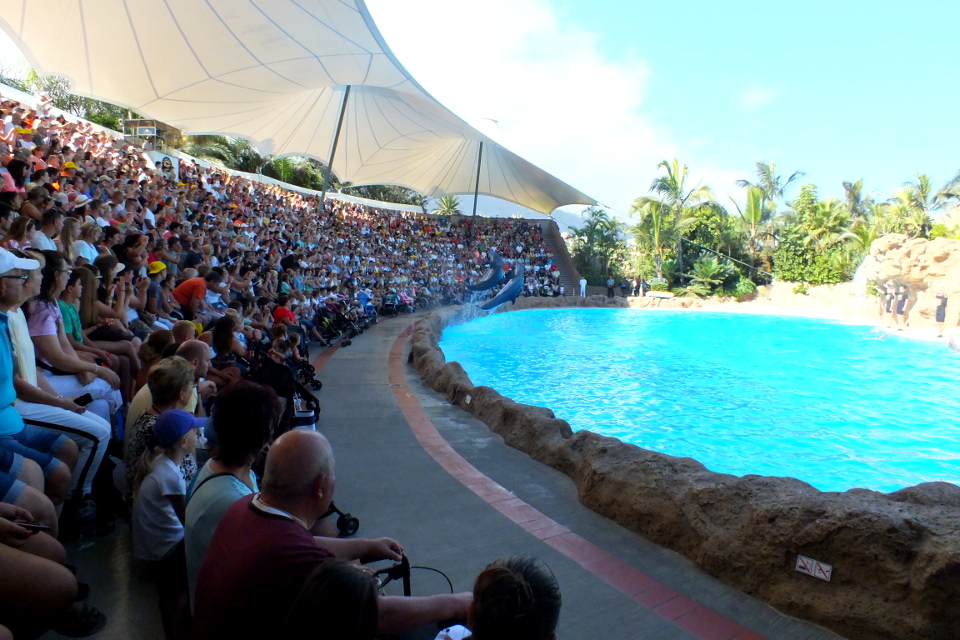Exclusive for zoos.media – 27.03.2017. Author: Philipp J. Kroiß
The science proves it: training in modern zoos and aquariums is fun for whales. In dolphins and whales, happiness hormones are found during training.
Whales are happy during training
There are many misunderstandings about whale training. One of the most important is that the animals are forced to do it. In addition, an image of training is presented by zoo-opponents which pictures it as negative for the animals and sells it as torture, constraint or compulsion.
Of course, we cannot ask dolphins how they find the training, but it is possible to establish some facts without going onto the thin ice of speculation. This is what this article will do.
In fact, it has been scientifically proven that whales enjoy training. But first we need to understand how the training of these magnificent animals works, and then consider the science behind it.
Training without constraint
Even in the pioneering period of dolphin conservation in Germany, it became clear that a principle that was applied with many other animals did not work: giving food in exchange for participation in training to generate motivation.
In dogs, for example, this principle is known from the dog expert Martin Rütter (VOX); the idea is: “The dog will from now on only get his food during training.”
Of course, this was also tried with dolphins in the early 1960s: the feed was distributed in training units and then fed in the evening. Complete food withdrawal, as quickly became clear, was not possible anyway, because hungry dolphins cannot be trained, because they were so fixated on food that it was impossible to train them.
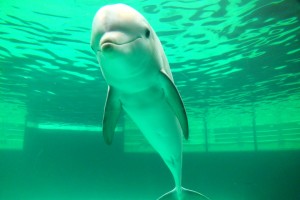
Early on came the realisation: hunger is not at all a sensible motivator for dolphins – the animals also encourage this conclusion. It is simply pointless to let the dolphins go hungry for something they do voluntarily. The fish is useful as a reward, but its absence is not a motivator, as in traditional operative conditioning. Today, the animals are rewarded with other things, such as strokes and toys, which work at least as well as mackerel.
It quickly became apparent in modern husbandry that the animals should first have breakfast before the caretakers start with the first training. You do not need hunger to motivate animals: fish, which could not be used as a reinforcement during training, are simply given to the animals. That hunger and indeed feeding are not a suitable motivator for training finally became apparent from experiments, in which animals were given the choice whether they got their food anyway or only with training. The animals chose training.
So what is the motivation for whales to participate in training? It is the training itself or, better, the interaction with the trainers with whom the animals have a special relationship. Fish is one of many possible rewards and not the limiting factor for successful training; there are even training sessions that can do without any fish. The animal plays along, because it wants to, not because it is somehow forced and would otherwise have to fear for its welfare.
Negative markers are not used during training: behaviour which is not desired during training is ignored and only desired behaviour is positively reinforced. There are therefore no prohibiting gestures or utterances, and certainly no punishments. This works much better than using “negative markers”. Recently, this experience from training with dolphins has been scientifically described even in an independent experiment with dogs.
The relationship with the animal is the key
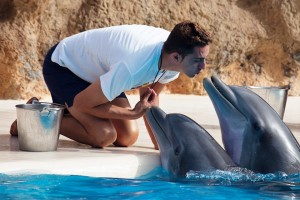
Dolphins cannot be successfully trained if they are forced or punished. So in modern facilities they decide for themselves whether they want to train or not and the only thing the trainer can give is an offer or an invitation. It’s the same as with all enrichments in modern zoological facilities: one can only offer it to the animals and the acceptance is up to them. If it accepts it, it’s great and if it doesn’t accept is, it’s no problem.
Whether a whale decides to participate in training depends on it and this decision-making is indeed left by any modern whale trainer to the animals. Nobody has to force such an animal to train, it usually joins training spontaneously and voluntarily. The principle of positive reinforcement also means no punishment, because only the intended behaviour is positively reinforced by a reward. Any negative reinforcement would destroy the work of the trainers and would be counterproductive, but also, of course, no good for the animal.
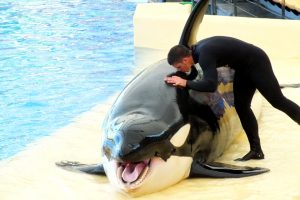
Thus, of course, the relationship between the dolphin and the human is crucial: dolphins have the experience that interaction with trainers is fun. That is why they come to them. In doing so, however, trainers, in turn, do not have to take other fun factors, such as toys, away from the animals – even the trained animals. The animals have so many possibilities to deal with: sometimes they also play with each other and then need neither humans nor toys – they can do, what they want.
A whale trains with a human being because, to put it simply, it is fun for the animal.
This seems to be a truly challenging argument. Isn’t it too anthropomorphic? A sketchy thesis on thin ice? An erroneous distortion of reality? No. It is science.
Dolphin training and happiness hormones
The exploration of the “language” of whales is a popular branch, which requires researches in the wild and in human custody alike to get a comprehensive picture of the subject. Part of this research has been devoted to ‘Victory Squeals’. These are so-called success squeals, which dolphins emit when they find that they have done something completely good and celebrate their perceived success.
Comparable vocalisations have been found in the wild as well as in human captivity – since the 1960s. Since then, this squeaker has continued to assess the scientist Sam Ridgway. He initiated the research and collected data. The aim was to demonstrate emotion-filled sounds in dolphins. It is now established that victory squeals are associated with a dopamine output (Ridgway et al., 2014).
Dopamine is regarded as the happiness hormone. It is assumed that the sense of happiness of the hormone has the biological role of motivating the recipient with a positive feeling and increasing its drive. People also release it when they have a sense of happiness, or, to put it simply, are experiencing fun, joy or happiness.
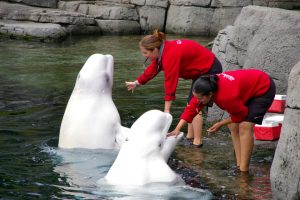
Now the important question for this article is: where did he research this? He has proved the existence of the victory squeals in the wild and in human custody, but in wild animals it is not even possible to carry out the necessary investigations into hormonal distribution. This is not necessary, however, because the phenomenon is not significantly different on the basis of its location. The dopamine levels were measured during the training of the animals – quite explicitly for large bottlenose dolphins and white whales, which were trained appropriately with stress-free sampling. However, the findings can also be applied in other ways.
Ridgway’s research has thus not only described the victory squeal and its nature, but also, almost by the way, provided the scientific proof of what well trainers have long known: modern training, as described above, actually gives these animals fun, or triggers happiness, which is synonymous, in everyday language parlance.
